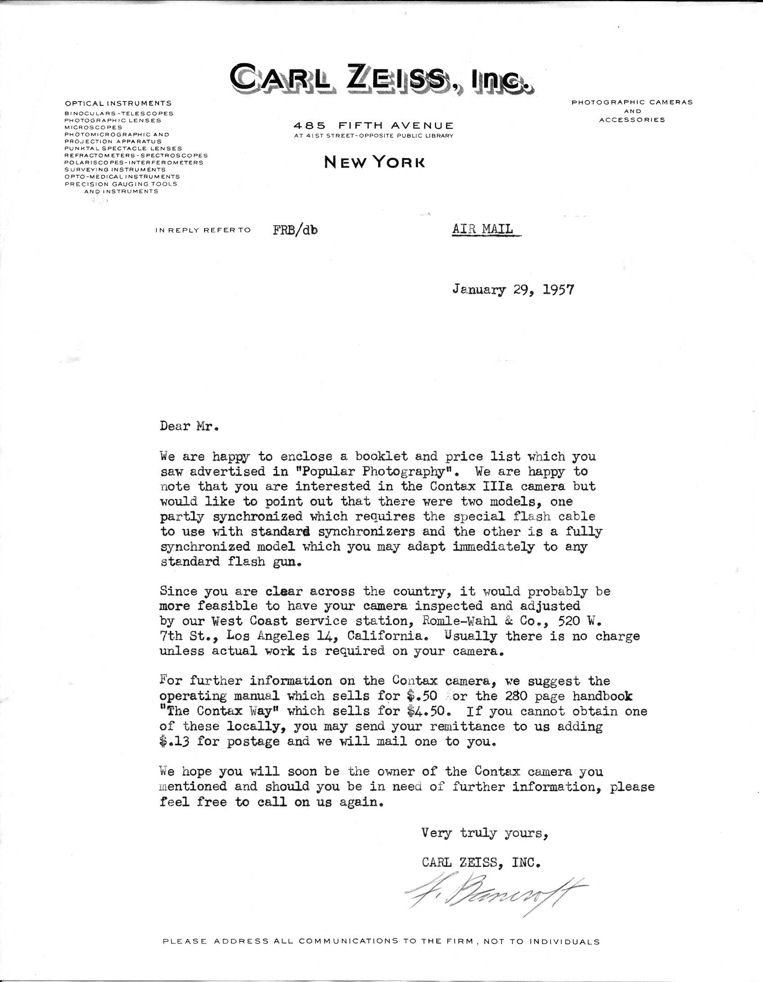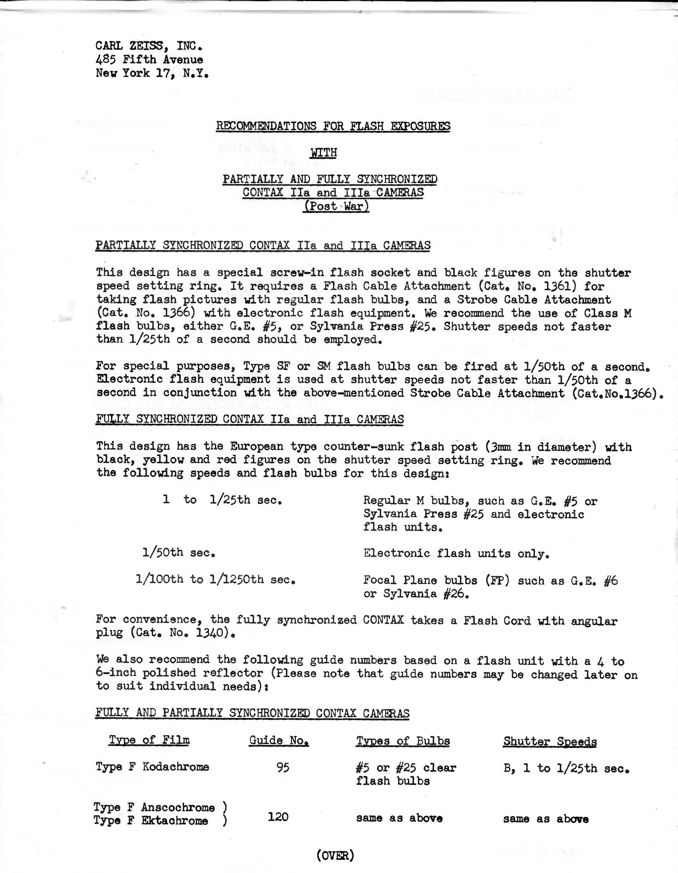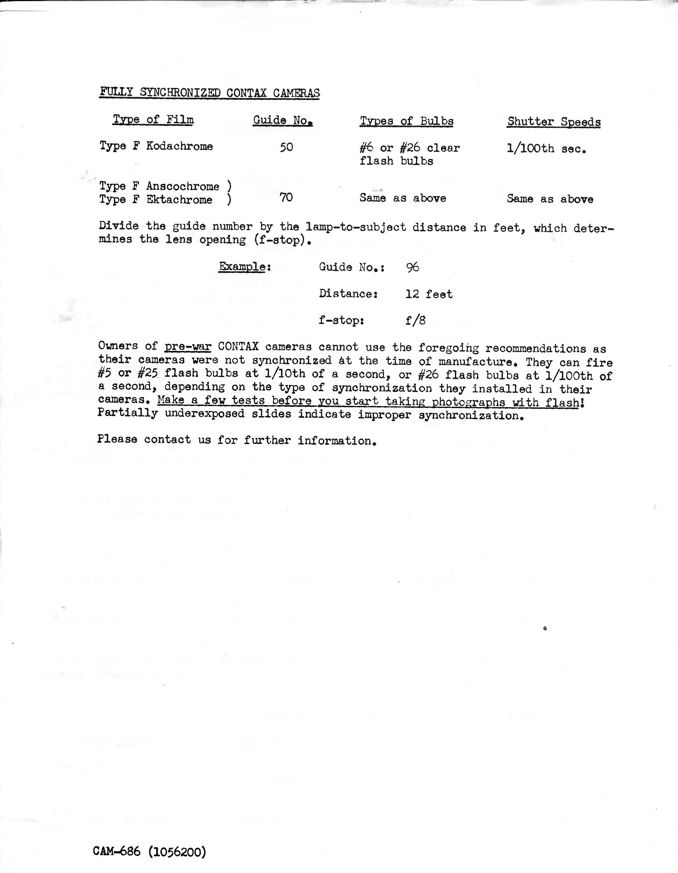Zeiss Ikon Contax Camera Repair
A home for your Zeiss Ikon Contax, Contarex or Super Ikonta camera!
- Home
- Information
- Articles
Index
What does Color Dial and Black Dial Mean?
There are basically two variations of both the postwar IIa and IIIa cameras. The first IIa and IIIa cameras produced after the end of W.W.II, starting in 1951 had flash synchronization built into the camera. This was a first for Zeiss since both the II and III pre war camera models had no flash synchronization capability. The type of flash synchronization used on the early IIa and IIIa camera bodies was relatively simple and was mechanical. An accessory electronic switch was required to connect to the camera. It screws into the little flash synchronization socket provided on the upper back of the camera. This switch provided the electrical components for flash synchronization and provided the PC type female electrical socket to connect the flash unit to.
The shutter speed selector dial on the Contax IIa and IIIa models having mechanical flash synchronization have black paint filling all of the engraved shutter speeds. This is why these cameras are referred to as "Black Dial" models.
There are two models of accessory flash synchronization switches and these are No. 1361 and 1366. The No. 1361 switch was intended for use with flash bulbs and the 1366 was designed for use with electronic flash. In actual practice today they are both the same and can be used with electronic flash interchangeably. In the early 1950's the triggering voltage for an electronic flash was very high. For this reason the No. 1366 flash switch has large and heavy electrical contacts in it. The flashbulb voltage was very low and so the No. 1361 switch had smaller contacts in it. Both the 1366 and the 1361 work by the same mechanism. The only visible difference is that the 1361 is about half the size of the 1366 due to the smaller contact set inside it.
Starting sometime in about 1953 or 1954 Zeiss changed the Contax IIa and IIIa camera body to incorporate all of the necessary electrical parts for flash synchronization inside the camera itself. Instead of a mechanical connection on the camera back there is a modern type female PC electrical socket. The shutter speed selector dial on these cameras have colored paint filling the engraved shutter speeds and this is why this camera model is referred to as the "Color Dial".
The Color Dial camera requires no accessory switch for flash synchronization. All that is needed is to plug the electronic flash PC cord into the camera socket and flash synchronization is automatic. The shutter speed dial speeds are filled in with different colored paint to indicate the type of flash synchronization provided at the various shutter speeds. Speeds 1 sec to 1/25 are in black indicating M synchronization for bulbs and electronic flash. Speed 1/50 is in yellow to indicate both X and M synchronization for both bulbs and electronic flash and speeds 1/100 to 1/1250 are in red indicating there is no flash synchronization at these speeds.
The Color Dial and Black Dial models were sold at the same time as separate models. This is stated in a three pae Official Zeiss Letter from 1957:



Why is the Contax IIa Color Dial Camera so Expensive?
The Contax IIa Color Dial camera is actually one of the more rare cameras. There were perhaps no more than 3,000 of them made. It's only today that talk about them is abundant that they appear to be much more plentiful than they ever were.
There are several reasons why the IIa Color Dial model is rare. The first is that the first Contax camera Zeiss produced after the end of WWII was the Contax IIa Black Dial. Then, starting in about 1953 Zeiss began manufacturing the Contax IIIa Black Dial model. In the 1950's and 1960's, when the Contax IIa and IIIa were being made, the Contax IIIa was the more preferred model and many more of them were made and sold than the IIa. There are two reasons for this. The first is that both the Contax IIa and IIIa were extrordinarily expensive cameras. A brand new Chevrolet sedan could be bought for the same price as a Contax IIIa. The IIa was only $100.00 less. Anyone who could afford a IIa could also afford a IIIa. The second reason is that the IIIa was seen to be the more advanced and better camera. The IIa was seen to be the "second line" model. People who bought a Contax back them wanted a IIIa most of all.
It wasn't until sometime in 1954 that Zeiss changed the II and and IIIa camera from the Black Dial to the Color Dial models. This was not accompanied by any big announcement or advertising campaign. It was quietly done and accepted as part of the normal progression of improvement that all camera makers of the time were implementing. It was a very competetive time in the 35mm camera business. In 1954 people were still largely using flash bulbs because electronic flash units then were battery devouring unreliable lead heavy dinosaurs that provided little light and which cost as much as a camera. It just wasn't a big deal then for a camera to have X synchronization.
From 1954 on most of the Contaxes Zeiss produced and sold were IIIa Color Dial models. Another artifact of the extreme high cost of this camera is that anyone who could afford to buy a IIIa Color Dial could likely afford to buy it with the best and most expensive lens of that time which is the 50mm f1.5 Sonnar. Back then the 50mm f2.0 Sonnar was seen as an "economy" model lens and the now highly prized 50mm Tessar was seen as the "poverty" model lens.
The result of the public perceptions and the high cost of the Contax IIa and IIIa cameras at the time they were being made is that about 10 IIIa's were made for every IIa; and most IIIa's were sold with the 1.5 Sonnar and most of the IIa's were sold with the f2.0 Sonnar.
Today the IIa is in fashion. It seems that just about everyone wants a Contax IIa Color Dial with a 50mm f.1.5 Sonnar on it. There were very few Color Dials IIa's made, most of them were sold with a 50mm f2.0 Sonnar on them and this makes things complicated today. It also makes a Contax IIa Color Dial with a 50mm f1.5 lens on it to be an extrordinarily rare and expensive thing to find and buy. In many cases it is necessary to buy a camera with the 50mm f2.0 lens on it and then find a separate 50mm f1.5 lens. This makes for big expense.
If you are definitely in the market for a Contax postwar camera and you don't want to spend an arm and a leg for it consider the IIIa Color Dial. There are a lot more of them, most of them come with the 50mm f1.5 Sonnar and the lightmeter is a very good one that can be completely restored to be very useful and accurate with modern color film. Both the II and the IIIa take the same picture, use the same lenses and accessories and are otherwise the same except the IIIa has a lightmeter in it.
The question often arises can a Black Dial model be converted to be a Color Dial model? The simple answer is no. The reason is that the flash synchronization electrical system in the Color Dial model is very complex. It contains four separate electrical switches along with contacts and wiring. The shutter release mechanisms are entirely different. It is basically an entirely different camera and the basic frame of the shutter is also different. There is just no way to do such a conversion. This has not stopped people from trying. Every now and then I get sent a Contax IIa Black Dial into which someone has put a PC type socket in place of the mechanical socket. These home brew Rube Goldberg type conversions have only one effect and this is to ruin the action of the shutter so that it will not work reliably. Repairs and restoration of these cameras is always very expensive and always necessary. Please take my advice: Never ever buy a converted camera. Don't even buy one for parts. They are simply cameras that have been ruined.
